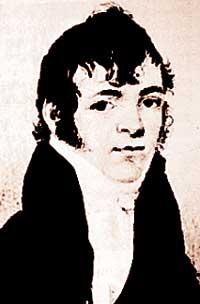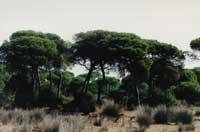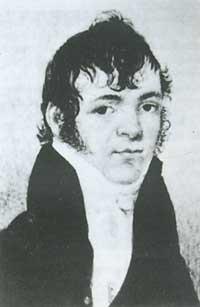Gabiria Mine, ancient
1998/06/01 Antiguedad, Iñaki Iturria: Elhuyar aldizkaria
Until Doñana happened, many people probably did not know the Gabiria. In this municipality, located in the Goierri, live more than 400 people working in the industrial estates of the area. Although most of the gabirios are dedicated to industry, they live in the hamlets of their municipality of residence, since the urban core is very small; the homes closest to the dozen dozen, are organized around the church, the town hall, the school, accommodation and the association, on a small summit. Of course, also the pediment.
What was described could be a typical photo of several villages in the Basque Country and this could be said if the Doñana disaster had not occurred. After Doñana's case, Gabiria has appeared several times in the media. Doñana does not like taste, passion for landscape and ecosystems, but it is not for this reason that it is the point of contact of television cameras, radio microphones and newspaper lines.
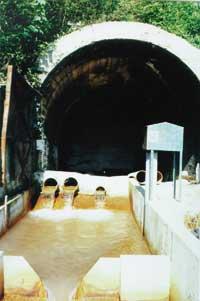
Unfortunately, the reason is another. In fact, in Gabiria it has been possible to satisfy the hunger of the media to find parities when disasters occur, because for this it is located and in this small town of Goierri.
In the description of the votes cast above, there is a loophole that, if nothing had appeared in the media, would not even have been mentioned…, but which singles Gabiria with other peoples. In Gabiria, we descend below the village to Ormaiztegi and take the road to Mutiloa, a Trojan mine, now closed but open until a few years ago. Under this mine, a dam. Therefore, the parity between Doñana and Gabiria. According to data from the Basque Government, of the 83 mining wells existing in the Autonomous Community, Gabiria is the only one that can cause environmental damage. Seen from the surface, at first glance, the situation seems very similar; with a certain depth, it must be seen.
In 1986 the company Exminesa occupied 6 hectares for 20 years between Gabiria and Mutiloa, since through surveys they knew that there was a soil rich in lead and zinc. The Troy mine opened in 1987 to close it six years later. The production was good, but with much competition they closed it. During the opening period of the Exminesa mine it extracted 1,646,632 tons of ore. The entire mine as well as the surrounding grounds were closed and sold. By then there had already been a change of image, since that clean and orderly place showed another face: forest tracks with dust, area without trees, buildings of little appearance, ruins of mine and well of water.
As mentioned above, the small well, much smaller than the one that caused the massacre in Doñana, with capacity to house 1,050,000 cubic meters, but which, however, can be considered. Like the Aznalcólel dam, it was a well of water that collected the water to clean the mineral that came out of the Trojan mine. The minerals extracted from the Trojan mine were mainly cleaned with cyanide and copper sulfates, between 30-80 grams of cyanide per ton of cleaned ore and 200 grams of sulfates per ton of cleaned ore.
During the six years they worked in the Troy mine, these poisonous substances were used that, mixed day by day with water and mud, were calmed in the depth of the dam. And today, they are in the background, covered with water and hidden behind the wall that apparently closes the dam. Apparently kept, since according to the report of the Provincial Council on the rivers of Gipuzkoa of 1995-96, the mine of Troy continued to pollute the channel of Eztanda.
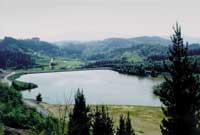
After being sold, “Asphalts Urretxu S.A½ bought the entire Trojan mine. José Mari Uria is one of the owners of this company. He participated in the entire purchase operation and has since participated in the movements that have existed around the mine. “We bought this from Exminesa when it went to Auction, with the intention of building a slag recycling factory in the mine area. For this we obtained the necessary authorizations, both by the City Council and by the Department of Industry, but with a condition that everything was solved. The problem is that when closing a mine you have to put everything as before, you can't close it and you're done! do. We realized this when we started taking steps to carry out our project. Exminesa for his part did nothing, so we ordered it.
In Gabiria they had to do a great job to give the well and the environment its current appearance and become aware of the danger that the remains of the mine run. “Yes it is true, there was intense material, which had come out and came out of the bureaucrats; I don’t know what I had but nothing good. Here it was not uncommon to finish the work with headaches, nor to have skin itching.
To cover everything we moved 100,000 cubic meters of land, cast a dam 10 meters wide, dry the earth to the sun, cover, place the channels of the mountain waters very loose with clay soil… so that the well is waterproofed. The water from the raft, the metal water from the mine itself (about 50 liters per second on average) is cleaned by decanting. The technicians of the Council control everything that is here, take it up to date, appearing at any time. Compared to the previous one, now the environment does not look bad; we throw crabs into the well, ducks and other birds walk through the water… If you were abroad someone would have happened to put some hotel or restaurant.
Affirming in some way the words of José Mari Uria, the representatives of the Diputación and the City of Gabiria have also had room in the media to say that, in addition to conducting checks at any time, they are now about to make a deeper study. José Mari Uria wants nothing but to do, to do the necessary studies and to carry out the recycling business as intended. “It is intended to collect and recycle the surpluses generated in the foundries for later use in road construction. It is a technology already underway in different parts of Europe, able to collect casting slag and asphalt roads. We have technology, space and desire, but we lack permission.

The measures taken by José María Uria and his work team have significantly improved the situation of the Gabiria dam, which was at least the first garbage area and toxic waste collection point, today you can see ground cover and green grass cover, since the water that goes to the dam leaves cleaner and the entrance to the mine is closed avoiding the expulsion of pollutants. However, it does not seem enough, as the ruins covered with earth continue to be poured in small amounts due to the influence of rainfall. According to experts, in order for this not to happen, the deposit should be isolated and filtered.
To find a definitive solution there is a plan drawn up by the Autonomous University of Madrid, called a program to definitively end the mining exploitation of Troy. According to this Plan, the only solution is the total isolation and not the drying of the dam, since with this measure the toxic substances would remain where they are. Pyrite remains should be under layers of soil built in different phases, but after water treatment. In addition, sludge containing high metals and cyanides should be collected, transported to an appropriate location and treated properly.
It is curious what needs to be done so that this area of Gabiria shows the same aspect and situation that a few years ago, the question is who and when. Let's see if soon the media have talked about it again.

Gai honi buruzko eduki gehiago
Elhuyarrek garatutako teknologia




